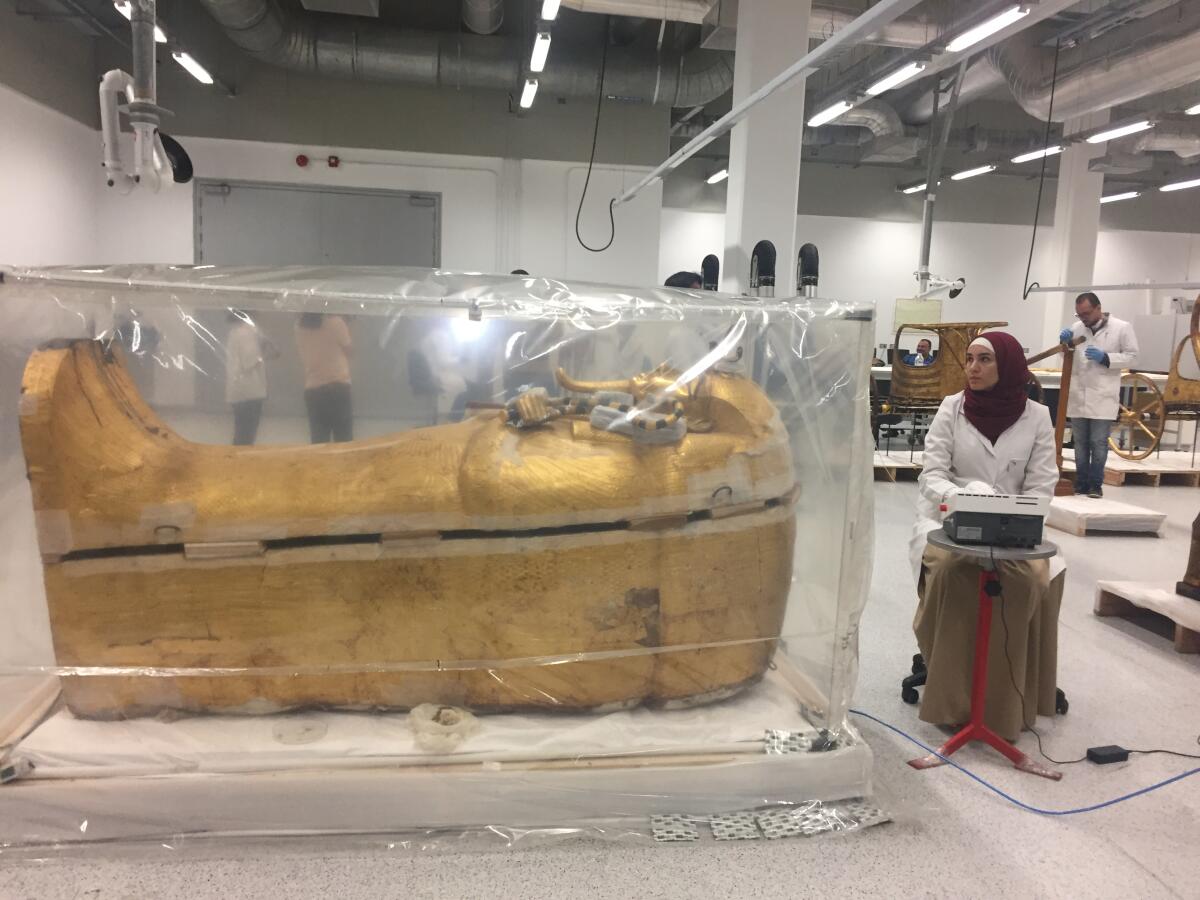King Tut’s coffin is in ‘very bad condition’; Egypt begins restoration

- Share via
GIZA, Egypt — Egypt is restoring one of King Tutankhamen’s coffins for the first time since its discovery in 1922, part of the preparations for next year’s opening of the country’s lavish new museum overlooking the Pyramids of Giza, where the relics from the boy king’s tomb are expected to be the biggest draw.
Restorers at the laboratory for wooden objects at the Grand Egyptian Museum have begun fumigating the gilded coffin, after it was carefully moved from Tutankhamen’s tomb in Luxor’s Valley of the Kings in southern Egypt amid tight security last month.
The wooden coffin is the largest of the three concentric coffins inside which King Tut’s mummy was found. This outer coffin had remained within the tomb until now, while the two inner coffins have been on display at the Egyptian Museum in central Cairo. All three will be on display together for the first time when the museum opens late next year.
The golden relics of Tut, evoking the life, mysterious death and storied afterlife of the 19-year-old Egyptian King Tutankhamun, is, for many of us, embedded in our childhood memories — along with those long, long entrance lines.
The coffin was in a “very fragile” state, Minister of Antiquities Khaled Anany said on Sunday, speaking to reporters invited to see the relic. “We made first aid intervention, then we moved the coffin to the museum. It was kept in the isolation hold during seven days. Then the fumigation started a few days ago for three weeks.”
The coffin is about “30% damaged” because of high temperatures and humidity inside the tomb, said Eissa Zeidan, general director of First Aid Conservation and Transportation of Artifacts, standing inside the laboratory. “The coffin is in a very bad condition, very deteriorated. We found many cracks, we found many missing parts, missing layers.”
The 7-foot, 3-inch-long gold coffin, which depicts the boy king as Osiris, the Egyptian god of the afterlife, was resting inside a plastic incubator in one of the 17 state-of-the-art laboratories at the new museum, surrounded by restorers in white lab coats who were working on other treasured pieces from the tomb including a chariot and ritual bed.
The restoration process is expected to take eight months.
Speaking a few feet in front of the coffin, the general director of conservation at the museum, Hussein Kamal, explained the main challenges. “There are a lot of fragments,” he said. “We should study the original place of each piece” to properly reattach them to the coffin, he added.
The new museum, which is still under construction, will display for the first time all of the more than 5,000 artifacts that were found in Tutankhamen’s tomb nearly a century ago in Luxor.
The exhibition will cover more than 75,000 square feet, Anany said, and form the centerpiece of what will be the biggest museum in the world dedicated to a single civilization when it opens. “Tutankhamen would be the star in any museum in the world,” he added.
The international fascination with the Golden Pharaoh was apparent just last month after Christie’s Auction House in London sold a 3,000-year-old bust of King Tut for $6 million, a sale that Egypt tried to stop. There are concerns that it might have been looted from an Egyptian temple.
Egyptian officials say that Christie’s hasn’t provided the documentation that would prove the artifact left the country legally. Christie’s said that the bust has been on exhibition for a number of years before the sale without complaint from the Egyptians. It has also published a chronology of its owners for the last 50 years.
Egypt said it had asked for Interpol’s help in retrieving the bust.
Modifications to existing law in Egypt are also being pursued, Anany added, so that “the sale of objects without proof even abroad is forbidden.”
More to Read
Sign up for Essential California
The most important California stories and recommendations in your inbox every morning.
You may occasionally receive promotional content from the Los Angeles Times.










